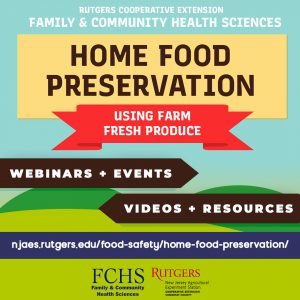 Our Ag & Natural Resources (ANR) Chair Nick Polanin shared that our Rutgers Cooperative Extension Family & Community Health Science Department (FCHS) has developed social media posts (below) and the attached mini posters for use by on-farm & community farm markets to promote safe home food preservation. These direct users to the NJAES home food preservation webpage. The posters are provided in full color and less color versions for websites or printing.
Our Ag & Natural Resources (ANR) Chair Nick Polanin shared that our Rutgers Cooperative Extension Family & Community Health Science Department (FCHS) has developed social media posts (below) and the attached mini posters for use by on-farm & community farm markets to promote safe home food preservation. These direct users to the NJAES home food preservation webpage. The posters are provided in full color and less color versions for websites or printing.
Face Book: Please share this Facebook post: https://www.facebook.com/SCNJFCHS/posts/2008602745963285
Instagram text to copy & paste the jpg photo attached and the following text:
Preserve Your Farm Fresh Produce
With the help of @fchs.rutgers, you can now access a harvest of free information for preserving your farm fresh produce!
Filled with webinars, events, videos, and all kinds of other resources, the home food preservation website is great for making everything easy to understand and digest, all while helping you learn through tutorial, expert publications, and more.
You can access the full site here: njaes.rutgers.edu/food-safety/home-food-preservation/
This is also a valuable way of finding specific classes or speakers, as well as learning more about your county’s local FCHS office, their programs and events.


